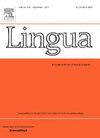区分翻译和非翻译外交话语的语言指标:联合国一般性辩论的历时分析(1946-2022)
IF 1.3
3区 文学
0 LANGUAGE & LINGUISTICS
引用次数: 0
摘要
本研究考察了联合国一般性辩论(UNGD)中区分翻译和非翻译英语外交话语的语言特征,并调查了这些特征在1946年至2022年期间是否发生了变化,以及这些变化是否与英语语言种类有关。弹性网络回归分析发现,翻译文本的形式性、抽象性和信息密度高于非翻译文本,这与已有的翻译语言研究结果一致。随着时间的推移,翻译后的文本在语言变化方面往往落后于未翻译的演讲,这支持了联合国翻译是一种保守的语言变体的观点:联合国翻译人员在采用创新用法方面往往很慢,更喜欢已有的变体。品种差异在选择翻译特征方面也很明显。这些发现有助于理解翻译语言,并强调了考虑历时分析和变化影响与翻译语言特征的重要性。本文章由计算机程序翻译,如有差异,请以英文原文为准。
Linguistic indicators differentiating translated and untranslated diplomatic discourse: A diachronic analysis of the United Nations General Debate (1946–2022)
This study examines the linguistic features that distinguish translated from untranslated English diplomatic discourse at the United Nations General Debate (UNGD) and investigates whether these features change from 1946 to 2022 and vary in relation to English language varieties. The translation features identified by elastic net regression analysis suggest that translated texts exhibit higher levels of formality, abstractness, and informational density than untranslated texts, aligning with existing studies on translated language. Over time, the translated texts tend to lag behind untranslated speeches in terms of language change, supporting the notion that UN translation is a conservative language variety: UN translators tend to be slow in adopting innovative usages, preferring established variants. Varietal differences are also evident in relation to the selected translation features. These findings contribute to the understanding of translated language and underscore the importance of considering diachronic analysis and varietal influences in relation to the features of translated language.
求助全文
通过发布文献求助,成功后即可免费获取论文全文。
去求助
来源期刊

Lingua
Multiple-
CiteScore
2.50
自引率
9.10%
发文量
93
审稿时长
24 weeks
期刊介绍:
Lingua publishes papers of any length, if justified, as well as review articles surveying developments in the various fields of linguistics, and occasional discussions. A considerable number of pages in each issue are devoted to critical book reviews. Lingua also publishes Lingua Franca articles consisting of provocative exchanges expressing strong opinions on central topics in linguistics; The Decade In articles which are educational articles offering the nonspecialist linguist an overview of a given area of study; and Taking up the Gauntlet special issues composed of a set number of papers examining one set of data and exploring whose theory offers the most insight with a minimal set of assumptions and a maximum of arguments.
 求助内容:
求助内容: 应助结果提醒方式:
应助结果提醒方式:


